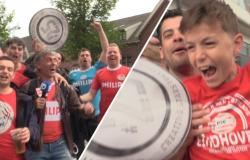Did you know that more than half of all inhabitants on Earth are younger than the Hubble Space Telescope? Yet the beloved stargazer is certainly not throwing in the towel just yet. On his 34th birthday we celebrate this with a beautiful photo of the Little Dumbbell Nebula.
The Lesser Dumbbell Nebula (M76) is a planetary nebula in the constellation Perseus. The nebula is 3,400 light-years from Earth. At the center of the nebula is a dying star, a red giant that is transforming into a white dwarf. The surface of this star is about 120,000 degrees Celsius, or 24 times warmer than the surface of the Sun. If you look very closely, you will see the dying star as a white dot in the center of the nebula.
Why is this nebula called the Little Dumbbell Nebula?
The Little Dumbbell Nebula was discovered in 1780 by the French astronomer Pierre Méchain and was included in the famous Messier catalog the same year. Since the nebula had many similarities to M27 – the Dumbbell Nebula – but was slightly fainter, the object was named the Little Dumbbell Nebula.
From Earth we look at the side of the ring. That’s the thick structure in the middle. If we saw the nebula from the front, the Little Dumbbell Nebula would resemble the Ring Nebula. A major advantage of the current perspective is that the two gas lobes to the left and right of the ring are clearly visible. These bubbles are pushed out at a speed of more than three million kilometers per hour.
The Little Dumbbell Nebula can be seen for a relatively short time. The mist will disappear in 15,000 years. That seems far away, but on a cosmic scale it is nothing. Our universe is 13.7 billion years old, while the solar system has been around for 4.6 billion years.
Hip Hip, hooray!
Since its launch in 1990, Hubble has made more than 1.6 million observations. In total, more than 53,000 astronomical objects have been examined. More than 44,000 scientific papers have been published on Hubble observations. The space telescope is therefore – scientifically speaking – the most productive space mission in NASA’s history. Hopefully we can enjoy the space telescope for a long time to come.
Tags: Hubble blowing candles today celebrating spectacular space photo







